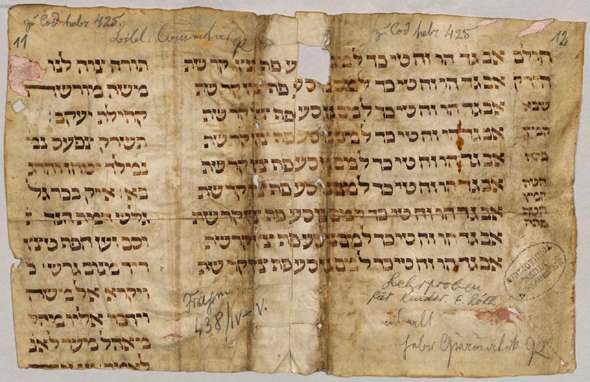The words on the left side are the verses תורה צוה לנו, Moses commanded us a law, an inheritance of the congregation of Jacob (link), and ויקרא אל משה, And the LORD called unto Moses, and spoke unto him out of the tent of meeting, saying . . . (link). In between are two Kabbalistic versions of the אלפא ביתא. The first, Tashrak Tzaphas is the Aleph Bet backward grouped into "words," Ayak Bechar, which involves arranging all 27 letters (including the five finals) in a table three by nine. Then read horizontally, you get איק בכר, etc. Finally, there is an excerpt from a larger medieval teaching mnemonic like "The Quick Brown Fox," הקץ עצל דיך מנום גרש כזב פן תוסף חטא.

And with this a boy would begin to learn Torah (but no haircut).
Unfortunately I could find out nothing about this manuscript, except that I think it belonged to Johann Reuchlin's collection. It's in the Munich Bayerische StaatsBibliothek, the same library with the famous and unique Talmud manuscript (link).
Speaking of Reuchlin, while it's well known that he learned Hebrew grammar from Rabbi Ya'akov ben Yechiel Loans (Jacobus Jehiel Loans Hebræus as he refers to him) and Rabbi Ovadya Sforno (link), less well known is that he was initially taught the Aleph Bet and how to read Hebrew from a melammed named Kalman (Calman Judæus, Elementarius præceptor) and, no, I did not just make this up.

Why do you make the aleph superscript? In our Torah-scrolls, it's small (not the same as superscript), but not in this manuscript. Aren't you trying to accurately present what's in the manuscript?
ReplyDeleteI did the best I could. I think the HTML would make a small letter rest on the bottom while it should rest on the top.
ReplyDeleteAlso, I was not trying to represent the manuscript, otherwise I would have typed everything including fill letters, or whatever the kids are calling them these days.
ReplyDeleteI give permission for the hat tip!
ReplyDeleteThank you so much forהקץ עצל דיך מנום גרש כזב פן תוסף חטא. I heard it years ago and never made a note of the text, and have tried to Google for it many times without success.
ReplyDeleteThere is actually a passuk, in Tzefaniah if I remember right, in which all the letters of the alpahbet are used, like the quick brown fox. So there was no need to invent a phrase. I have it in my notes. I can look it up and repost if you're intressante.
ReplyDeletei'm laughing at the right side of the page. teaching nikkud without the nikkud. surely one line would have sufficed with instructions to repeat it each time with a different vowel.
ReplyDeletethere is a genizah fragment at jts that was a student's primer, but i don't remember anything about it.
"no, I did not just make this up."
i guess i'm missing something, but what exactly would we think you made up?
i can't find the jts specimen, but there is T-S K5.13 at cambridge (10th c.)
ReplyDeletei haven't seen this article, but http://jss.oxfordjournals.org/content/48/1/47.abstract
found one at jts:
ReplyDeletehttp://alpha3.jtsa.edu:8997/F/HT16KQF2YAB49XUP6BR77TTSNGR57YMQ5ER5ULFYTATC2A19RA-11089?func=full-set-set&set_number=003390&set_entry=000001&format=999
see in the notes to this record for some secondary literature and call numbers of other jts genizah primers
also see the explnation of ayak bechar
DF: yes indeed, Tzefania 3:8, but it has a lot more than 27 letters ;-)
ReplyDelete>i guess i'm missing something, but what exactly would we think you made up?
ReplyDeleteSorry, sometimes I'm immersed in my own thoughts and am not clear enough. As far as I can tell, it is not common knowledge that he was taught the basics of Hebrew from a melamed named Kalman, and most people think Loans was his first teacher.
Re teaching nikud without nikud, that's why I don't think this was really a teaching primer, but just one for repeating, probably in a stylized first-time sort of way.
and most people think Loans was his first teacher.
ReplyDeleteNo, S, most people haven't heard of Reuchlin. Or (probably) Hebrew, for that matter.
LOL
ReplyDelete